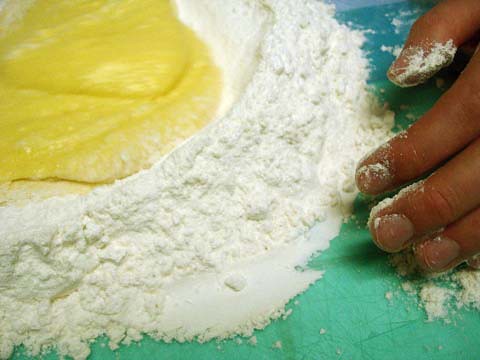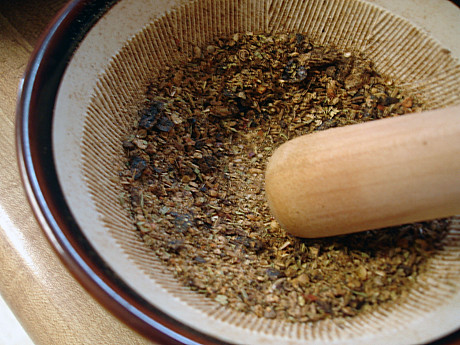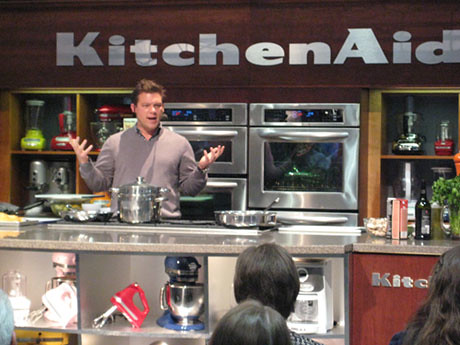
I know talking about the importance of cooking to readers of your food blog is preaching to the choir, but I wanted to highlight a few things from Michael Pollan’s latest article in the New York Times Magazine. Pollan is a Knight Professor of Journalism at Berkeley best known for his book, The Omnivore’s Dilemma. I’ve been following his work since he called Twinkies “synthetic cream-filled pseudocakes” in an article two years ago about the problems with the U.S. farm bill. I also liked that he used the phrase “head-hurtingly complicated” a few paragraphs later.
His new article looks at what it means to “cook” in the age of fast food chains, frozen PB&J and more squeezable products than I like to think of. Pollan explores the relationship between the decline of true cooking and the rise of Food Network. “The Food Network has helped to transform cooking from something you do into something you watch,” he says.
Food on television has changed a lot since Julia Child prepared meals live and unedited. Sure, it’s called “reality” TV, but it’s manipulated on every level: makeup, lighting, editing, music, pre-measured ingredients, multiple takes, etc. The Food Network and other food shows have moved away from teaching people to cook and are increasingly about absurd challenges:
“We learn things watching these cooking competitions, but they’re not things about how to cook. There are no recipes to follow; the contests fly by much too fast for viewers to take in any practical tips; and the kind of cooking practiced in prime time is far more spectacular than anything you would ever try at home. No, for anyone hoping to pick up a few dinnertime tips, the implicit message of today’s prime-time cooking shows is, Don’t try this at home. If you really want to eat this way, go to a restaurant. Or as a chef friend put it when I asked him if he thought I could learn anything about cooking by watching the Food Network, ‘How much do you learn about playing basketball by watching the N.B.A.?’
What we mainly learn about on the Food Network in prime time is culinary fashion, which is no small thing: if Julia took the fear out of cooking, these shows take the fear — the social anxiety — out of ordering in restaurants. (Hey, now I know what a shiso leaf is and what “crudo” means!) Then, at the judges’ table, we learn how to taste and how to talk about food. For viewers, these shows have become less about the production of high-end food than about its consumption — including its conspicuous consumption. (I think I’ll start with the sawfish crudo wrapped in shiso leaves. . .)”
 I don’t know. If you care enough about food to have such knowledge and order such a dish, then you probably have a higher standards for what qualifies as cooking, too. Maybe you’ve tried to make your own pasta dough. At the very least, you make your own sauce. But you don’t count adding fluorescent powder to milk and noodles as cooking, and you don’t even want to talk about Easy Mac.
I don’t know. If you care enough about food to have such knowledge and order such a dish, then you probably have a higher standards for what qualifies as cooking, too. Maybe you’ve tried to make your own pasta dough. At the very least, you make your own sauce. But you don’t count adding fluorescent powder to milk and noodles as cooking, and you don’t even want to talk about Easy Mac.
In the world of food blogging, standards for cooking are higher everyday. Have you rolled your own sushi? Infused your own oils? Baked your own graham crackers and oreos? Made your own yogurt or ricotta? Oh great, you’ve made hummus from dried garbanzos you soaked yourself? Well, now everyone is using fresh garbanzos, get with the program.
 But we’re still a small subset of the population. Pollan talked to a food-marketing researcher who is convinced the majority of Americans are too far gone in their eating/cooking habits because they’re “cheap and lazy.” Not to mention, busy. So Pollan sees cooking as becoming recreation instead of daily necessity.
But we’re still a small subset of the population. Pollan talked to a food-marketing researcher who is convinced the majority of Americans are too far gone in their eating/cooking habits because they’re “cheap and lazy.” Not to mention, busy. So Pollan sees cooking as becoming recreation instead of daily necessity.
It’s “a backyard sport for which we outfit ourselves at Williams-Sonoma, or a televised spectator sport we watch from the couch. Cooking’s fate may be to join some of our other weekend exercises in recreational atavism: camping and gardening and hunting and riding on horseback. Something in us apparently likes to be reminded of our distant origins every now and then and to celebrate whatever rough skills for contending with the natural world might survive in us, beneath the thin crust of 21st-century civilization.”
 I’m with Pollan on that one, and I’m sure a lot of you are, too. How satisfying does it feel to knead dough or grind spices?
I’m with Pollan on that one, and I’m sure a lot of you are, too. How satisfying does it feel to knead dough or grind spices?
A lot more than it is opening a bag of Wonderbread or using a packet of onion soup mix.


